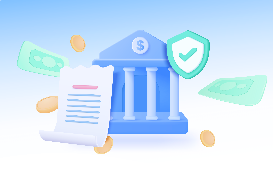Inflation and interest rates
Understanding the relationship between inflation and interest rates
Inflation reduces purchasing power: Moderate inflation is normal, but high inflation increases living costs and may weaken savings.
The Federal Reserve manages inflation with interest rates: Raising interest rates can slow inflation, while lowering them can stimulate spending.
Choosing the right savings account can be helpful: High-yield savings, certificates of deposit, and money market accounts can help to protect against inflation.

What is inflation?
You have most likely heard the term inflation before, but what exactly is it? And what is the relationship between inflation and interest rates?
Inflation is the rate at which the general level of prices for goods and services rises over time, reducing the purchasing power of money. Inflation is an important economic indicator, and is influenced by factors such as demand, supply chain, and government policies.
Moderate inflation is normal within a growing economy, but high inflation can bring negative consequences, such as eroding savings and increasing the cost of living.
One key indicator of high inflation is the quick increase of prices— for example, when you notice the cost of your usual weekly groceries has suddenly increased. Deflation, or falling prices, on the other hand, is the opposite of inflation and happens when prices decline, increasing purchasing power.
What causes inflation?
Many factors can influence inflation, but the root cause is said to be an imbalance between supply and demand. More specifically, this happens when the quantity of demanded goods at a specific price level outpaces the quantity supplied at the same price level. This imbalance can drive prices higher as consumers compete for limited goods and services.
Factors influencing inflation are oftentimes categorized into the following:
Demand-pull inflation: This occurs when consumer demand for goods and services exceeds supply, causing businesses to raise prices. This may be triggered by increased government spending, rising wages, or strong consumer confidence.
- Cost-push inflation: This happens when production costs rise (i.e. wages, raw materials, supply chain disruptions), forcing businesses to pass said costs down to consumers, through an increase in prices.
- Built-in inflation: This is driven by the expectation that prices will continue to rise, prompting businesses to increase wages and prices in anticipation of inflation — essentially creating a self-reinforcing cycle.
Many other external factors, such as global supply chain disruptions, geopolitical events, and monetary policies, can also contribute to inflation. Understanding these causes can help central banks and consumers navigate periods of inflation more effectively.
The Federal Reserve and inflation
Central banks, such as the Federal Reserve — also known as the Fed — manage inflation by adjusting interest rates and other monetary policies, in an attempt to keep inflation rates within a stable range. Because of this, inflation rates and interest rates usually move in the same direction. Therefore, when inflation is too high, the Fed will increase interest rates to slow down the economy and lower inflation. On the other hand, if inflation is too low, the Fed will usually lower interest rates, stimulating the economy and, in turn, increasing inflation.
The Fed aims to keep a positive inflation rate — targeted at 2% — meaning a constant rise in overall price levels for services and goods, because deflation would be more detrimental to the economy. Maintaining positive levels of inflation and interest rates also allows the Fed to lower rates with more flexibility, in the case of economic slowdowns.
Furthermore, the Fed also needs to meet objectives from Congress, which were initially established in the Federal Reserve Act of 1913, with the goals of maximum employment and maintenance of stable prices. This is also known as the Fed’s “dual mandate.”
Essentially, the Fed works together with the government’s fiscal policy to try to raise or lower rates the right amount — not too high or too low — to get the best balance of employment opportunities, while maintaining stabilized prices.
How inflation is measured by the Federal Reserve
The Federal Reserve measures inflation primarily through two key economic indicators, being:
Consumer Price Index (CPI): The CPI is published by the Bureau of Labor Statistics (BLS), and tracks the average change in prices consumers pay for a broad basket of goods and services, including food, housing, healthcare, and transportation. This indicator reflects inflation from the perspective of the consumer.
Personal Consumption Expenditures Price Index (PCE): The PCE is the Fed’s preferred measure of inflation. It is published by the Bureau of Economic Analysis (BEA), and measures changes in prices of goods and services purchased by households. Unlike the CPI, it accounts for shifts in consumer behavior, such as switching to cheaper alternatives when prices rise.
Additionally, the Fed often looks at the core versions of these indexes, which exclude volatile food and energy prices, to provide a clearer view of long-term inflation trends. By analyzing inflation measures, the Fed can adjust monetary policy — again, through changes in interest rates — to help stabilize prices.
The Federal Reserve’s targeted inflation rate
At this point, you may be asking yourself — if the Fed influences inflation and interest rates, why don’t they just keep inflation at 0%? However, even though it may sound ideal, keeping inflation at 0% is not entirely beneficial for the economy. This is why most central banks, including the Fed, do not aim for zero inflation.
Economists focus on two main benefits of maintaining a small, but positive, amount of inflation.
The first being that it helps to safeguard the economy from spiraling into deflation — which can be just as problematic inflation, or more.
The second being, it may lead to improved labor market efficiency.
So if inflation is not meant to be kept at zero, what is the targeted rate?
The aim is to keep inflation around a steady 2% per year. This measure comes from the Federal Open Market Committee (FOMC), the Fed’s body which sets monetary policy, and also created the 2% PCE inflation objective. Many central banks across the globe have their own inflation objectives, and some have even adapted a target inflation rate of 2%. This rate was chosen, as it is often associated with good economic performance.
Although the FOMC has remained consistent with maintaining this 2% objective, an occasional increase in average inflation would be necessary from time to time to reach long-term inflation and employment goals. This can potentially lead to inflation fluctuating above or below the 2% target rate.
Changes in inflation and interest rates
Increasing and decreasing interest rates can be helpful in managing pressures on the economy caused by inflation. But, can inflation also affect interest rates?
Interest rates are the cost of borrowing — or saving — money. There are many reasons why interest rates change. If the Fed increases interest rates, borrowing money becomes more expensive, causing consumers and businesses to think twice about taking out loans for larger purchases or investments. In turn, this slows down spending, eventually lowering overall demand, and with hope, reducing inflation.
However, higher interest rates are also beneficial for saving. They might encourage consumers to look into a safer option for storing their money, such as high-interest savings accounts. These accounts can offer competitive interest rates for savings, which would benefit from higher interest rates. The Raisin marketplace allows you to compare interest rates within savings account options, allowing you to choose between competitive rates. Learn how to position your savings accordingly and take advantage of high interest rates.
On the other hand, lowering interest rates makes borrowing money cheaper, encouraging spending, investing, and borrowing. This can be particularly stimulating to the economy, especially when trying to encourage economic growth. Although Fed rate cuts could impact savings, saving money can still be an important strategy — even when rates are low.
How inflation and interest rates affect savings
Due to the correlation between inflation and interest rates, you might be wondering how this affects your savings and finances. We have already discussed how inflation can increase the overall prices of goods and services, but how does this affect your savings?
In this case, the same principle would apply — meaning that even though the amount of money in your savings might fluctuate over time (depending on your deposits and withdrawals), its real value may decrease if the interest you earned does not keep up with the pace of inflation. This is where interest rates also come into play.
For example, if your savings were earning you 2% interest, and inflation increased by 4%, you wouldn't necessarily experience a loss of 2% in the amount of money in your account, but on its purchasing power. This means while your balance may continue to grow, you would actually be able to buy less, essentially making it harder to reach long-term financial goals. However, with the right savings account, you could potentially mitigate this loss by choosing one with an interest rate that keeps up with inflation, and avoid a decrease in purchasing power.
Choosing the right savings account to keep up with inflation
By setting financial goals and adjusting your financial planning, you may be able to minimize the effects of inflation on your savings. Understanding the different types of savings accounts, and selecting one to best fit your needs, can help protect your purchasing power as prices rise.
While traditional savings accounts are widely available, they often offer lower interest rates that may not keep up with inflation. Here are some alternative savings options to consider:
High-yield savings accounts: These accounts offer significantly higher interest rates than traditional savings accounts, allowing your money to grow at a faster rate. High-yield savings accounts typically have low to no fees and usually do not require a minimum balance, making them a flexible option for mitigating the effects of inflation.
Fixed-term certificates of deposit (CDs): Also known as traditional CDs, these accounts allow you to lock in a fixed interest rate for a set period, ranging from a few months to several years. This may be beneficial when interest rates are higher, as it guarantees a stable return. However, withdrawing funds before the term ends can result in penalties.
No-penalty CDs: Similar to traditional CDs, no-penalty CDs offer fixed interest rates but provide the flexibility of withdrawing your funds before the maturity date, without incurring a penalty. These tend to have lower interest rates than traditional CDs, but offer more liquidity in the event that you need access to your money.
Money market accounts: Money market accounts combine the features of both savings and checking accounts, usually offering higher interest rates than traditional savings accounts. They typically come with higher minimum balance requirements, and may have limited monthly withdrawals — however, the ones offered through Raisin only require a $1 minimum deposit and do not have withdrawal limits.
By exploring these savings options, you can find an account that aligns with your financial goals and may help counteract the effects of inflation over time.The Raisin marketplace offers a wide range of high-interest savings accounts, making it easier to find a savings account that fits your needs and could help you keep up with inflation.
Bottom line
Inflation is a normal part of the economy, and moderate inflation can indicate a healthy financial system. However, when inflation rises too quickly, causing prices to surge, central banks and policymakers may intervene by increasing interest rates — hence why interest rates and inflation rates usually move in the same direction. Higher rates can help curb excessive spending, which may, in turn, slow down economic activity and help ease inflation. On the other hand, rising interest rates can incentivize saving, as high-interest savings accounts tend to offer better returns in a high-rate environment.
Raisin can help you find the best high-interest savings option to take advantage of high interest rates and help deal with fluctuating inflation. Discover high-interest accounts with Raisin and start maximizing your savings today.
The above article is intended to provide generalized financial information designed to educate a broad segment of the public; it does not give personalized tax, investment, legal, or other business and professional advice. Before taking any action, you should always seek the assistance of a professional who knows your particular situation for advice on taxes, your investments, the law, or any other business and professional matters that affect you and/or your business.


